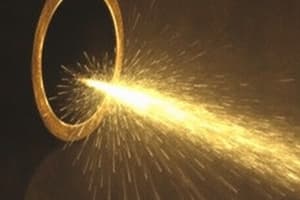Podcast
Questions and Answers
What is a magnetic particle used for?
What is a magnetic particle used for?
- Locating surface discontinuities
- Locating near surface discontinuities
- Detecting material separation
- Both A and B (correct)
What describes a ferromagnetic material?
What describes a ferromagnetic material?
- Strongly attracted by a magnet
- Not capable of being magnetized
- Capable of being magnetized
- Both B and D (correct)
What does the permeability of a material describe?
What does the permeability of a material describe?
- Depth of the magnetic field in the part
- Ability to retain the magnetic field
- Ease with which it can be magnetized (correct)
- Length of time required to demagnetize it
What does the retentivity of a material describe?
What does the retentivity of a material describe?
Why are magnetic particles available in different colors?
Why are magnetic particles available in different colors?
Which of the following materials can be magnetized?
Which of the following materials can be magnetized?
When is the magnetic field strongest?
When is the magnetic field strongest?
If a crack exists in a circular magnet, what causes the attraction of magnetic particles to the crack?
If a crack exists in a circular magnet, what causes the attraction of magnetic particles to the crack?
What unit is usually used to denote flux density?
What unit is usually used to denote flux density?
Which statement is true when related to magnetic lines of force?
Which statement is true when related to magnetic lines of force?
What do magnetic flux lines that are parallel to a discontinuity produce?
What do magnetic flux lines that are parallel to a discontinuity produce?
A part is adaptable to magnetic particle inspection if?
A part is adaptable to magnetic particle inspection if?
What rule describes the direction of current flow (+ to -) when lines of magnetic force surround a conductor?
What rule describes the direction of current flow (+ to -) when lines of magnetic force surround a conductor?
The magnitude of the residual magnetic field in a specimen is dependent on what?
The magnitude of the residual magnetic field in a specimen is dependent on what?
The proper number of ampere-turns for a given test specimen is determined by?
The proper number of ampere-turns for a given test specimen is determined by?
A circular field may be induced into a specimen by?
A circular field may be induced into a specimen by?
What type of field does an electrical yoke produce?
What type of field does an electrical yoke produce?
What does a coil around the part produce?
What does a coil around the part produce?
In longitudinal magnetization, what is the proper term for calculating magnetizing force?
In longitudinal magnetization, what is the proper term for calculating magnetizing force?
What is true about magnetic lines of force?
What is true about magnetic lines of force?
When is magnetic particle build-up from a discontinuity strongest?
When is magnetic particle build-up from a discontinuity strongest?
How may a specimen be demagnetized?
How may a specimen be demagnetized?
What is an advantage of magnetic particle testing over penetrant testing?
What is an advantage of magnetic particle testing over penetrant testing?
The amount of amperage used for magnetic particle inspection using the prod method is determined from what?
The amount of amperage used for magnetic particle inspection using the prod method is determined from what?
What is the flux within and surrounding a magnetized part or around a conductor carrying a current known as?
What is the flux within and surrounding a magnetized part or around a conductor carrying a current known as?
What are the areas on a magnetized part from which the magnetic field is leaving or returning called?
What are the areas on a magnetized part from which the magnetic field is leaving or returning called?
What is a metal that is difficult to magnetize said to have?
What is a metal that is difficult to magnetize said to have?
Flashcards
Permeability
Permeability
A measure of how easily a material can be magnetized.
Ferromagnetic Material
Ferromagnetic Material
A material strongly attracted to a magnet and can be magnetized.
Magnetic Particle Inspection
Magnetic Particle Inspection
A nondestructive testing method that detects surface and near-surface discontinuities in ferromagnetic materials using magnetic fields and particles.
Retentivity
Retentivity
Signup and view all the flashcards
Magnetic Particle Color
Magnetic Particle Color
Signup and view all the flashcards
Magnetic Field Strength
Magnetic Field Strength
Signup and view all the flashcards
Leakage Field
Leakage Field
Signup and view all the flashcards
Flux Density Unit
Flux Density Unit
Signup and view all the flashcards
Magnetic Lines of Force
Magnetic Lines of Force
Signup and view all the flashcards
Magnetic Particle Indications
Magnetic Particle Indications
Signup and view all the flashcards
Study Notes
Magnetic Particle Inspection
- Definition: Magnetic particle is a nondestructive examination method used for locating surface and near-surface discontinuities.
- Ferromagnetic Materials: Ferromagnetic materials are strongly attracted by a magnet and can be magnetized.
- Permeability: Permeability describes the ease with which a material can be magnetized.
- Retentivity: Retentivity describes a material's ability to retain a magnetic field.
- Different Colors: Magnetic particles are available in different colors for contrast with the part's surface to enhance indication detection.
- Magnetizable Materials: Iron, nickel, and cobalt can be magnetized.
- Magnetic Field Strength: The magnetic field is strongest when magnetizing current is flowing, and when the material exhibits high coercive forces.
- Cracks: Cracks in a magnet cause leakage fields, which pull magnetic particles.
- Flux Density: Flux density is measured in gauss units.
Magnetic Lines of Force
- Paths: Magnetic lines of force follow the path of least resistance.
- Directionality: The lines never cross and are most dense at the poles.
- Discontinuities: Parallel lines indicate no discontinuity, while non-parallel lines indicate a discontinuity.
Magnetic Particle Inspection Principles
- Disassembly: Disassembling parts before inspection enhances visibility of all surface areas.
- Types of Fields: Residual fields are most difficult to demagnetize, while longitudinal fields are the most sensitive.
- Current Types: Alternating current (AC) is the most effective at highlighting surface indications.
- Visualization Techniques: Methods like wet and dry methods, and the use of prods, all have various applications.
- Sensitivity: Continuous method provides better sensitivity than residual when locating sub-surface discontinuities.
- False Indications: False indications can occur due to magnetic particle attraction, either mechanically or gravitationally.
- Magnetic Particle Techniques: Methods such as magnetic particle testing with DC or AC currents have various advantages.
Other Important Terms and Concepts
- Curie Temperature: The temperature at which a material loses its ferromagnetic properties, usually through heat treatment.
- Residual Magnetism: The magnetic field remaining in a material after the magnetizing field is removed.
- Hysteresis Curve: A graph that shows the relationship between magnetizing force and the resulting magnetic field strength within a material.
Studying That Suits You
Use AI to generate personalized quizzes and flashcards to suit your learning preferences.




